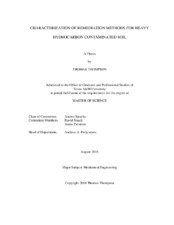Characterization of Remediation Methods for Heavy Hydrocarbon Contaminated Soil
Abstract
Hydrocarbons are a prominent fuel source for many different types of applications. Due to transportation and handling, spills and leaks may contaminate the surrounding soil. Soil contamination has adverse effects on the environment that could lead to harming wildlife and humans. It is essential to find an effective remediation method in order to clean the soil. Currently, remediation methods can be categorized into two categories: non-energetic methods (includes solvents, dispersion, and bioremediation) and methods that involve energy addition.
Energy addition remediation includes incineration, thermal desorption, pyrolysis, and a newly proposed technique using an electron beam. This study focused on the characterization and quantification of hydrocarbons removed by several of the energy addition methods, including: incineration, thermal desorption, pyrolysis and electron beam treatment at several energy levels. Temperature Programmed Reaction experiments were used to characterize background, untreated, and treated soils to determine the type of hydrocarbon content, either mobile or fixed, that is in the soil sample and the efficacy of the various remediation processes.
Results from the study found that incineration is the method that removes the most hydrocarbon content, followed by thermal desorption. Pyrolysis converted a fraction of the mobile hydrocarbons content to fixed carbon content. Several (energy) levels of E-beam treatment were also able to convert a portion of the mobile hydrocarbon content to fixed carbon content, elucidating new details of how the E-beam mechanism works; namely by a combination of thermal desorption and thermochemical conversion.
Citation
Thompson, Thomas (2016). Characterization of Remediation Methods for Heavy Hydrocarbon Contaminated Soil. Master's thesis, Texas A&M University. Available electronically from https : / /hdl .handle .net /1969 .1 /187364.


